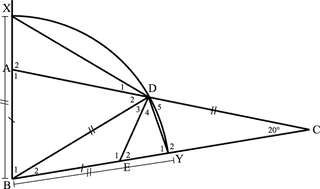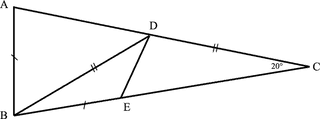Solution
The figure shows the arc and lines suggested by the hint. To find angle BDE = D_3, we find D_2, D_4, and D_5. Then subtract from 180 degrees.

1. △ABC is isosceles, therefore A1=80∘. △BDC is isosceles, therefore B2=20∘ and B1=60∘. Note also that A2=100∘.
2. △BDY is isosceles, therefore Y1=D3+D4=80∘. So D5=60∘. Note that Y2isnow100^\circ$.
3. △XBD is isosceles with B1=60∘, therefore △XBD is equilateral, hence ∠X=60∘ and XD=BD=DC.
4. ∠X=D5, XD=BD=DC, and D1=∠C=20∘, therefore △XAD≅△DYC by ASA.
5. From 4, we get XA=DY.
6. Since BX−BA=BY−BE, XA=EY. Thus EY=DY and △DYE is isosceles.
7. We now conclude that E2=D4=50∘.
8. In △BAD,
D2=180∘−B1−A1=180∘−60∘−80∘=40∘
9. D3=180∘−D2−D4−D5=180∘−40∘−50∘−60∘=30∘
This is the answer!

